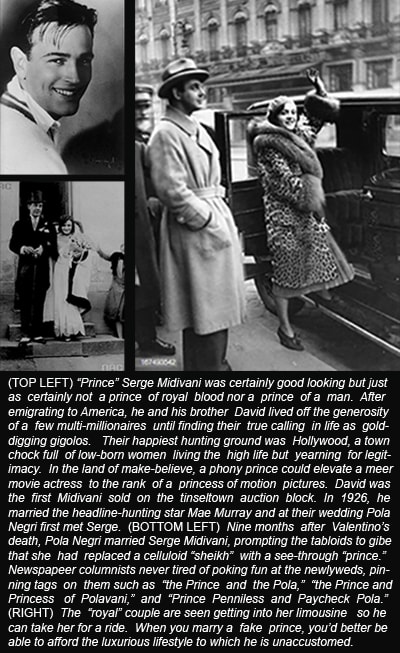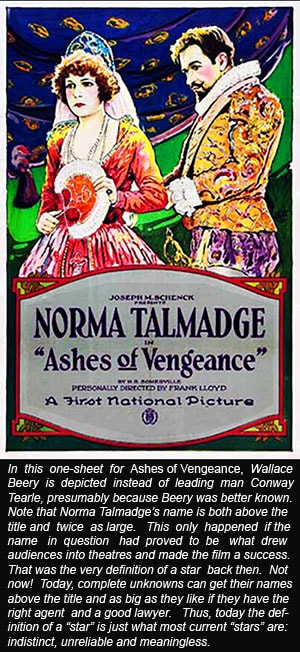The Conquering Power (1921)
Rudolph Valentino stars in Rex Ingram's adaptation of Balzac's classic novel, a tale of greed, manipulation, betrayal and the conquering power of love--a silent film classic revitalized with synchronized symphonic music, digital image enhancement, original title cards reproduction and a new opening titles sequence
Rudolph Valentino did not want to play the lead in The Conquering Power. The role of Charles Grandet, a Parisian dandy forced to woo his provincial cousin for her money after his father's death leaves him penniless, was hardly the sort of virile, scintillating role Valentino wanted and rightly felt he deserved. Playing a fey milquetoast now, at this pivotal point in his career, could destroy Valentino's exotic, seductive image and spoil the public's excitement and anticipation just when he was on the verge of becoming a major star.
He'd spent four long, lean years in Hollywood, visiting casting offices and chasing after every prospect for an interview or an audition, slowly working his way up from extra to bit player, from small featured roles to third leads in support of a star. Type-cast due to his dark, Mediterranean looks, he played gangsters, con-artists, gigolos or any other brand of non-American villain. Then his big break came when Alla Nazimova, a wildly avant-garde Russian actress racing against time to reach film stardom before middle age overtook her, cast him as Armand, the male lead opposite her in Camille. The part was stylish, sexy and sympathetic, a role that could grab the interest of audiences and the attention of producers--if the film was a hit. Released in August, 1920, the lavish Art Deco adaptation of the classic romance was a beautiful and expensive flop.
His hopes crushed, Valentino decided to quit Hollywood forever, relocate in New York, start a new life and a new line of work. While staying with friends in Greenwich Village, he read the popular novel about World War One, The Four Horsemen of the Apocalypse by Vicente Blasco Ibanez and became fascinated with the character of Julio, a fiery Argentinean playboy. Certain that the best-selling book would be adapted for the screen and realizing the part of Julio was perfect for him, Valentino searched the film-trade magazines until he read that Metro Pictures had purchased the film rights. Anxious to get an interview and hoping the role had not already been cast, he went directly to Metro's New York offices.
Upon arriving, he gave his name to a secretary who quickly ushered him into the office of writer and producer June Mathis. Before Valentino had a chance to state his case, Mathis told him she was preparing the film version of The Four Horsemen of the Apocalypse. She'd seen Valentino in the film Eyes of Youth and thought he'd be perfect for the role of Julio. She'd spent weeks searching for him in Hollywood before learning of his relocation. Still hoping to find him, she'd come to New York but after days without any success she decided to give up and go back to Hollywood. She was just about to call and make reservations for the train to Los Angeles when out of the blue and into her office stepped Valentino. They both believed destiny had brought them together that day--just as they both believed that the role of Julio would make Valentino a star.
They were right. The Four Horsemen of the Apocalypse became one of the highest grossing pictures of the silent era and as Julio, Valentino was a sensation. A new star had been born and the only people unaware of it were the executives at Metro Pictures. They rejected his request for a salary increase, they gave him no publicity and now they cast him in a role that could undo everything The Four Horsemen had done for him. It made no sense to him--until shooting started on The Conquering Power and he became the daily target of director Rex Ingram's bullying, belittling and humiliating campaign. Now he knew who was behind Metro's negligent treatment of him and he knew the reason for it.
Rex Ingram had never liked Valentino--and the feeling was mutual--but since The Four Horsemen the dislike on Ingram's part had soured into intense hatred. Ingram had directed the film that made Valentino a star and played no small part in guiding Valentino through a performance that thrilled audiences nationwide. Now, Ingram considered Valentino an ingrate for not giving him due credit and even worse, Valentino was now more famous and more popular than Ingram. Out of spite, Ingram wanted to punish Valentino.
Biding his time, Valentino endured the director's insults and abuse while making The Conquering Power and when the production ended, so too did Valentino's obligation to Metro Pictures. Soon after leaving Metro, where he'd earned $350 a week, he signed with Famous Players-Lasky--which would soon become Paramount Pictures--for a salary of $1,250 a week.
His first film for Famous Players-Lasky was The Sheik. Playing the title role not only made him one of the biggest stars in Hollywood but also confirmed his reputation as the great Latin Lover, exotic and passionate, an image so powerful that it remains the popular conception of Rudolph Valentino even now.
So treat yourself to the privilege of seeing Rudolph Valentino in one of his most atypical roles in the film he reluctantly made between his two greatest successes, as Sounds of Silents presents a GCM Production of a MaxManLA Video, The Conquering Power, revitalized with synchronized symphonic music, digital image enhancement, original title cards reproduction and a new opening titles sequence.
The link below offers FREE online viewing as well as several FREE downloading options.
THE CONQUERING POWER (1921) with SYNCH SYMPHONIC MUSIC
 |
| One-sheet advertisements for Metro Pictures' "The Conquering Power" 1921.Add caption |
He'd spent four long, lean years in Hollywood, visiting casting offices and chasing after every prospect for an interview or an audition, slowly working his way up from extra to bit player, from small featured roles to third leads in support of a star. Type-cast due to his dark, Mediterranean looks, he played gangsters, con-artists, gigolos or any other brand of non-American villain. Then his big break came when Alla Nazimova, a wildly avant-garde Russian actress racing against time to reach film stardom before middle age overtook her, cast him as Armand, the male lead opposite her in Camille. The part was stylish, sexy and sympathetic, a role that could grab the interest of audiences and the attention of producers--if the film was a hit. Released in August, 1920, the lavish Art Deco adaptation of the classic romance was a beautiful and expensive flop.
 |
| Newspaper ads for "The Conquering Power" with Rudolph Valentino, 1921.Add caption |
His hopes crushed, Valentino decided to quit Hollywood forever, relocate in New York, start a new life and a new line of work. While staying with friends in Greenwich Village, he read the popular novel about World War One, The Four Horsemen of the Apocalypse by Vicente Blasco Ibanez and became fascinated with the character of Julio, a fiery Argentinean playboy. Certain that the best-selling book would be adapted for the screen and realizing the part of Julio was perfect for him, Valentino searched the film-trade magazines until he read that Metro Pictures had purchased the film rights. Anxious to get an interview and hoping the role had not already been cast, he went directly to Metro's New York offices.
 |
| PHOTOPLAY magazine review of "The Conquering Power" 1921.Add caption |
Upon arriving, he gave his name to a secretary who quickly ushered him into the office of writer and producer June Mathis. Before Valentino had a chance to state his case, Mathis told him she was preparing the film version of The Four Horsemen of the Apocalypse. She'd seen Valentino in the film Eyes of Youth and thought he'd be perfect for the role of Julio. She'd spent weeks searching for him in Hollywood before learning of his relocation. Still hoping to find him, she'd come to New York but after days without any success she decided to give up and go back to Hollywood. She was just about to call and make reservations for the train to Los Angeles when out of the blue and into her office stepped Valentino. They both believed destiny had brought them together that day--just as they both believed that the role of Julio would make Valentino a star.
 |
| Filming "The Conquering Power" in 1921, director Rex Ingram, star Rudolph Valentino.Add caption |
They were right. The Four Horsemen of the Apocalypse became one of the highest grossing pictures of the silent era and as Julio, Valentino was a sensation. A new star had been born and the only people unaware of it were the executives at Metro Pictures. They rejected his request for a salary increase, they gave him no publicity and now they cast him in a role that could undo everything The Four Horsemen had done for him. It made no sense to him--until shooting started on The Conquering Power and he became the daily target of director Rex Ingram's bullying, belittling and humiliating campaign. Now he knew who was behind Metro's negligent treatment of him and he knew the reason for it.
 |
| Rudolph Valentino in his most atyhpical role, a Parisian dandyh, in "The Conquering Power" 1921.Add caption |
Rex Ingram had never liked Valentino--and the feeling was mutual--but since The Four Horsemen the dislike on Ingram's part had soured into intense hatred. Ingram had directed the film that made Valentino a star and played no small part in guiding Valentino through a performance that thrilled audiences nationwide. Now, Ingram considered Valentino an ingrate for not giving him due credit and even worse, Valentino was now more famous and more popular than Ingram. Out of spite, Ingram wanted to punish Valentino.
 |
| Examples of silent film director Rex Ingram's classical style in "The Conquering Power" 1921.Add caption |
Biding his time, Valentino endured the director's insults and abuse while making The Conquering Power and when the production ended, so too did Valentino's obligation to Metro Pictures. Soon after leaving Metro, where he'd earned $350 a week, he signed with Famous Players-Lasky--which would soon become Paramount Pictures--for a salary of $1,250 a week.
 | |
| Silent film actor Ralph Lewis plays the old misert Pere Grandet in "Ther Conquering Power 1921. | Add caption |
His first film for Famous Players-Lasky was The Sheik. Playing the title role not only made him one of the biggest stars in Hollywood but also confirmed his reputation as the great Latin Lover, exotic and passionate, an image so powerful that it remains the popular conception of Rudolph Valentino even now.
 | |
| Rudolph Valentino and Alice Terrry in "The Conquering Power" 11921. | Add caption |
So treat yourself to the privilege of seeing Rudolph Valentino in one of his most atypical roles in the film he reluctantly made between his two greatest successes, as Sounds of Silents presents a GCM Production of a MaxManLA Video, The Conquering Power, revitalized with synchronized symphonic music, digital image enhancement, original title cards reproduction and a new opening titles sequence.
The link below offers FREE online viewing as well as several FREE downloading options.
THE CONQUERING POWER (1921) with SYNCH SYMPHONIC MUSIC
 |
| Add caption |












































